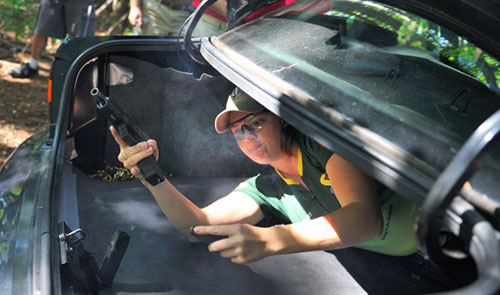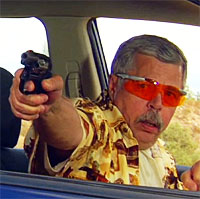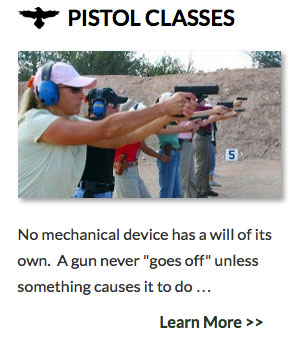Widgetized Section
Go to Admin » Appearance » Widgets » and move Gabfire Widget: Social into that MastheadOverlay zone
Is It Okay To Look At The Gun?

If glancing at the gun when reloading is a critical skill during a match, how important might it be during a lethal encounter? Photo Credit: Yamil Sued
It’s probably happening right now. On a training range somewhere an instructor is hollering at a student for looking at the gun during a reload. Since all training is “tactical” these days the conventional wisdom has it that manipulation of the weapon has to be accomplished without looking at the gun. The mantra is: keep your head up, your eyes down range and stay in the fight. There are some very good reasons for this line of thinking. Maintaining situational awareness is a good idea and staring at the gun while someone is trying to kill you is a really bad idea. Further reasoning involves preparing for fighting in the dark. What are you going to do if you can’t see the gun? If you haven’t trained to do reloads and malfunction clearances by feel you’re going to die. Right? So we practice these drills incessantly and instructors continue to yell at trainees.
Doing It In The Dark
Except for situations like being in the bowels of the Copper Queen mine when they turned the lights out, I’ve rarely experienced total darkness in the real world. There’s almost always some ambient light, and that means most of the time you’re going to be able to see your gun. Should you practice handling the gun in the dark? Sure, just don’t get carried away and neglect to spend the time you should on fundamentals – you know, sights and trigger?
Start by doing dry practice with an unloaded weapon. Close your eyes and do a reload or an immediate action malfunction clearance with dummy rounds. When you’re comfortable with your dry practice go to the range at night and, starting slowly with dry practice, work up to shooting the drills. Better yet, if you have access to an indoor range start by dimming the lights and finish with the range as dark as you can get it. Load several magazines with a mixture of live and dummy rounds and try to keep shooting as you work through malfunctions and reloads. You might be surprised at how this gives you a feel for what the gun is doing.
Looking At The Gun
As for looking at the gun during a reload, absent an instructor looking over your shoulder, I think you’re going to look at the gun just as you start to insert the magazine. And that’s perfectly okay, just don’t stare at the gun, what I call getting lost in the gun. How can I say you’re going to look at the gun, and tell you it’s okay, when your tactical instructor tells you it’s not? Because it’s what you’re going to do – you want to look at the gun- and you should.
Study the picture of champion shooter Randi Rogers above. This exceptional shot was captured by ace photographer Yamil Sued during the IDPA Nationals as Rogers was shooting and reloading while lying in the trunk of a car. This is a great picture because it illustrates a shooter doing everything exactly right, from positioning the pistol for the reload to moving her trigger finger off the trigger. As she starts the reload magazine into the pistol Randi glances down and looks at exactly where she wants the magazine to go before returning her attention to the sights. Note the look of concentration and fierce competitiveness on Randi’s face. She knows she might lose the stage, and perhaps the match, if she misses this reload so she does everything right and that includes looking at the pistol. Randi Rogers isn’t the only top competitive shooter to look at the gun during a reload; as a matter of fact, I dare say they all do. If glancing at the gun when reloading is a critical skill during a match, how important might it be during a lethal encounter? You need to do what’s necessary to solve your problem, whether winning a match or a gunfight. You want to look at the gun, it’s okay to look at the gun, just make sure you get your head back in the fight.
And don’t get me wrong – my intention here is not to slam well-meaning firearms instructors. They have your best interests at heart when they encourage you to avoid looking at the gun. They’re trying to emphasize the need to be aware of your surroundings and avoid tunnel vision. I make these points when I teach and take pride in demonstrating gun-handling skills while avoiding looking at the pistol. It looks cool, it’s fun to do and it sets a good example for the students. But when I’m shooting, especially when its for keeps, I make sure to look where I need to be looking when I need to be looking there.
Practice, Practice, Practice
Practice your gun handling skills, to include loading, unloading, clearing malfunctions and reloading until you’re performing them smoothly. You’ve probably heard this before, but it’s true that “smooth is fast”. Speed comes from practicing a skill correctly and smoothly every single time for as many as the several thousand repetitions necessary for the skill to become reflexive. A reflexive skill is one we’re able to perform without conscious thought. In the context of firearms skill building, what we’re talking about is having the ability to perform a skill smoothly and correctly, on demand, without having to think about the individual steps involved. Looking where you need to, for the brief moment necessary to make it happen, is an important part of becoming a smooth operator or competitor.
About the Author:
 Ed Head is a regular on Shooting Gallery and Down Range TV. He has worked for almost 30 years in law enforcement, first in the United States Air Force and then with the United States Border Patrol, retiring as a Field Operations Supervisor. During his Border Patrol career, Ed worked in a variety of patrol, investigative and training capacities. Ed has an extensive background as a firearms instructor, having trained thousands, ranging from beginners to police, military and special operations personnel. Having taught at Gunsite for 20 years, Ed first trained there under the world famous shooting school’s founder, Jeff Cooper, then later ran the school as the operations manager for more than five years. Ed lives in Chino Valley, Arizona, where he continues to teach and write.
Ed Head is a regular on Shooting Gallery and Down Range TV. He has worked for almost 30 years in law enforcement, first in the United States Air Force and then with the United States Border Patrol, retiring as a Field Operations Supervisor. During his Border Patrol career, Ed worked in a variety of patrol, investigative and training capacities. Ed has an extensive background as a firearms instructor, having trained thousands, ranging from beginners to police, military and special operations personnel. Having taught at Gunsite for 20 years, Ed first trained there under the world famous shooting school’s founder, Jeff Cooper, then later ran the school as the operations manager for more than five years. Ed lives in Chino Valley, Arizona, where he continues to teach and write.



 MidwayUSA
MidwayUSA Ruger Firearms
Ruger Firearms SCCY Firearms
SCCY Firearms Streamlight
Streamlight Action Targets
Action Targets Gunsite Academy
Gunsite Academy
You must be logged in to post a comment Login